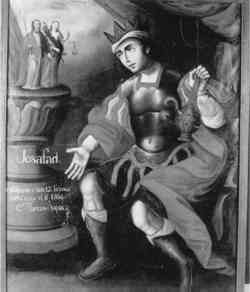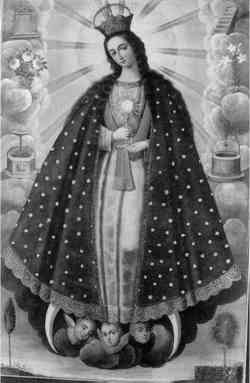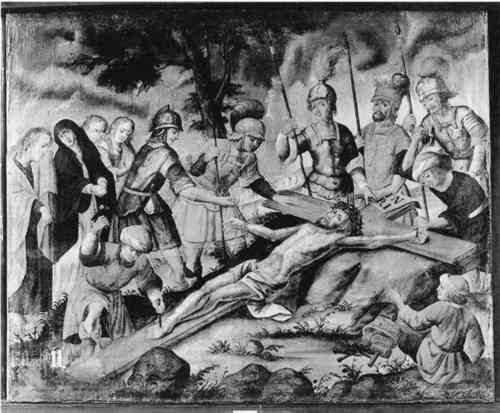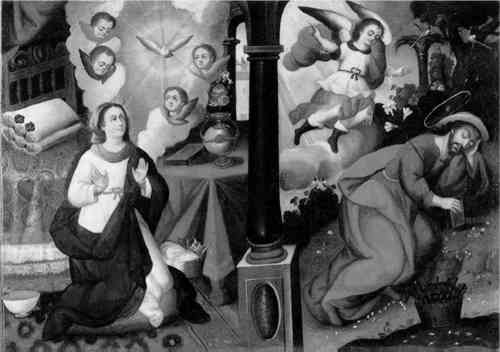BLUE PIGMENTS IN SOUTH AMERICAN PAINTING (1610–1780)ALICIA M. SELDES, JOS� EMILIO BURUC�A, MARTA S. MAIER, GONZALO ABAD, ANDREA J�UREGUI, & GABRIELA SIRACUSANO
4 BLUE PIGMENTS EMPLOYED SINGLY AND EXCLUSIVELY: INDIVIDUAL PAINTINGS AND THEMATICAL SERIES4.1 INDIGONatural indigo is an organic blue dye obtained from plants of the family Papilionaceae(Schweppe 1997). Due to its color and its fine granules, this dark blue powder may be easily confused with Prussian blue in paints. To distinguish them, reactions with 4N sodium hydroxide (4N NaOH) and with concentrated nitric acid (HNO3) were performed in all cases. In the first case, indigo remained unchanged, while Prussian blue went into solution to produce Indigo was used in 64 of the paintings studied. Table 1 lists the samples analyzed. Note that of the 64 paintings in which indigo was used, all but one were probably painted in Cuzco (see fig. 1 and appendix). TABLE 1. PAINTINGS WITH INDIGO AS SOLE BLUE PIGMENT
The vegetable dye indigo, also called a�il in Portugal and Spain, was produced in Guatemala in colonial times, according to the testimony of Antonio de Le�n Pinelo dated 1653 (Le�n Pinelo 1943, 249). There it was distributed in the Americas and Spain. Two 17th-century sources—the History of the New World, written in 1653 by the Spanish Jesuit Bernab� Cobo, and an anonymous manuscript, surely written by a converted Portuguese Jew, a subject of the ruling lords of Holland—credit the Central American origin of the a�il that was consumed in Peru: “Blocks [piedras] of all colors for paint are to be found in many places, such as a�il in chunk form [en piedra], very fine green, blue and all colors” (Cobo [1653] 1890, 289). “Also brought [to Lima]; … a�il and cochineal from the provinces of Guatemala and Nicaragua. … The City of Kings [Lima] has navigation for all the coast of Nicaragua, Guatemala and Sonsonate, and others. The ships go out with wine and return to Peru loaded with tar and tobacco and cochineal and a�il. … Some frigates also come here from Lake Maracaibo, loaded with flour and other cargo of a�il and cochineal” (Lewin 1958, 114). The presence of Indigofera growing in the territory of the Yucarar�, Siriono, Yunga, and Mache in the high jungle east of La Paz was documented late in the 18th century by the Czech naturalist T. Haenke (1898), a member of the Malaspina expedition, but there is no information as to whether any a�il made from it was used as a pigment by painters. A. Carrillo y Gariel (1946, 27) affirms that Indigofera a�il L. was grown in New Spain and that the Native Americans used the product as a pigment. He adds the comments of an English traveler, Robert Thomson, and a paragraph from Father Land�var's Rusticatio Mexicana, both of which specify different ways of curing the a�il exported from Guatemala. Among the classic Spanish writers on painting, V. Carducho ([1633] 1979)
Antonio Palomino, in 1723, accepts the inclusion of a�il for “working up” (labrar), that is, for developing the chiaroscuro and the details of blue surfaces (Palomino [1723] 1988, 156). The modes of curing a�il proposed by the Spanish and the way of using it in mixtures with other pigments were reviewed by Manuel de Samaniego of Quito at the end of the 18th century in his Tratado de Pintura. All these authors believed that it was preferable to use indigo to paint things considered “of lesser importance,” saving other, finer blue pigments for more important works (Vargas [1944] 1975, 96). 4.2 AZURITEAzurite is a pigment of mineral origin composed of a basic copper carbonate, 2CuCO3�Cu(OH)2(Gettens and FitzHugh 1993). Among the analytical criteria used for the identification of azurite are solubility and effervescence in cold 3N hydrochloric acid (3N HCl) and in concentrated HNO3(Gettens and FitzHugh 1993), performed on the cross sections. A test for copper in azurite using rubeanic acid (Plesters 1956) was performed on the samples, along with a test for the solubility in ammonia, to afford a deep blue solution of copper ammonia complex. SEM elemental analysis indicated in all cases the presence of copper as a sole component or sometimes with minor impurities, such as lead, silicon, calcium, aluminum, or iron. Azurite was found to have been used singly in five of the paintings in this study (see appendix). Seven samples were analyzed (table 2). TABLE 2. PAINTINGS WITH AZURITE AS SOLE BLUE PIGMENT Azurite is a pigment of mineral origin. It is obtained from a semiprecious stone similar to malachite, composed of carbonate of copper, whose use was registered by Pliny in the first century A.D. Ground into powder, it was used in tempera, in fresco painting, and with oil; in oil it often turns green, and for this reason Renaissance and baroque authors wrote at length about how to avoid this result. Pacheco and Palomino refer to this pigment as “fine blue or Santo Domingo blue” (Pacheco [1649] 1866, 80–82) and as “fine, thin blues of ashes” (azules de cenizas finas y delgadas) (Palomino [1723] 1988, 561), noting that the Spanish painters used it instead of ultramarine or lapis The archaeologist H. Yacobaccio (1995), among others, has shown that azurite was known and appreciated during pre-Hispanic times in what is now the Argentine Northwest. He found beads of this mineral, of a splendid blue color, in a burial dated A.D. 900 in Casabindo, Jujuy. It is known that azurite was mined from that time until the 16th century from Sapo Peak in Bolivia, department of Cochabamba, and in copper deposits on the Puna de Atacama. Le�n Pinelo recorded the existence of a mine from which “blue powder for painters” was obtained as late as the mid-17th century; it was located “in the province of the Chicha people, where it borders on that of Atacama near the town of Caspana, a mine worked by the Incas, although by now it yields little, being very deep” (Le�n Pinelo 1943, 266). Given that pre-Hispanic rock painting with traces of azurite has been found in Caspana, near the upper Loa River northeast of San Pedro de Atacama, it seems probable that the deposit described by Le�n Pinelo would have been of this mineral. He also mentions a “blue powder” that was extracted mainly from Santo Domingo, Hispaniola, which reinforces our 4.3 SMALTSmalt is an inorganic pigment of complex manufacture. It is a potassium glass of blue color due to the addition of small, variable amounts of cobalt. Its composition may vary considerably depending on the sources from which it was obtained (M�hlethaler and Thissen 1993). It is not a definite chemical compound. Besides its usual composition—SiO2 (66–72%), K2O (10–21%), CoO (2–18%), As2O3 (0–8%)—it might contain impurities such as oxides of barium, calcium, sodium, magnesium, nickel, iron, copper, and manganese (Winckler [1790] 1959). Microchemical methods were used on all the cross sections to evaluate the presence of smalt, including insolubility tests in cold 3N HCl, concentrated HNO3, and 4N NaOH (Plesters 1956). A spot test with rubeanic acid (Plesters 1956) was also carried out on all the samples. In addition, smalt was positively identified in all cases by SEM-EDS analysis. The presence of silicon, potassium, and cobalt in the expected percentages as main components allowed its identification, beyond minor amounts of different impurities such as iron, calcium, lead, arsenic, magnesium, aluminum, and sulfur. Smalt was used in 17 paintings (see appendix). Table 3 and figure 3 provide examples.
TABLE 3. PAINTINGS WITH SMALT AS SOLE BLUE PIGMENT Smalt is a synthetic material, and there is no record of its having been produced in the Americas before the second half of the 19th century (Bargall� 1955). The procedure for manufacturing smalt is as follows. Zaffer or zaffree, a cobalt oxide obtained laboriously by heating and pulverizing the mineral, is poured on a mass of molten glass, which acquires a blue color and is in turn immersed in cold water where it divides into granules. These granules are later ground fine to produce the smalt pigment. The color thus obtained probably was used in Europe in the 16th century, and there is no doubt that the technique of preparing zaffer from cobalt mineral was known at that time by metalworkers, glassworkers, and ceramists. In De subtilitate, a treatise full of magical fantasies and marvels but also of inventions and discoveries in optics, mechanics, and chemistry, Cardano refers to zaphera, “an earth that stains glass blue” (Neri et al. 1752, 49). The naturalist Ulisse Aldrovandi also speaks of it sometimes calling it an “earth” and others as a “stone” (Neri et al. 1752, 49). Scaligero, who wrote a treatise on glass, seems not to have known about zaffer (Neri et al. 1752, 47). In De re metalica Agricola did not call the pigment by that name, but he was the first to name it cobaltum or cadmia fossilis (Neri et al. 1752, 47). Only toward the end of the 17th century did chemists realize that cobalt, not copper, was the fundamental base of zaffer. Until then, no one had noticed that Agricola had provided accurate news about zaffer (Neri et al. 1752, 47). Despite Scaligero's contribution, the first treatise on the art of glassmaking to be known throughout Europe was L'arte vetraria by the Florentine priest Antonio Neri ([1612] 1678). It was published in Italian in 1612, translated into several languages and reedited on numerous occasions during the 17th century. In book 6, Neri reviews the processes for making smalt for glassmakers and goldsmiths and pays high tribute to zaffera in giving recipes for obtaining turchino and azzurro(Neri [1612] 1678, 147]. In 1669, a Latin edition of Neri's book was published in Amsterdam, surely increasing its potential circulation. In fact, an English edition of L'arte had already been published in 1667, with erudite comments by Christopher Merret1, the learned physician and alchemist, founding member of the Royal Society. This work must have been one of the first publications brought out by the society, only two years after it was founded. In his note on zaffer,
We have taken Merret's notes from a French edition of Neri and his commentators, Art de la Verrerie, dated in Paris 1752, and translated from the 1679 German edition by Baron D'Holbach himself. Merret also stated that the name zaffer came from “sapphire,” whose blue color it imitated. A few years later, in 1679, the famous German chemist Johann Kunckel2, published in Frankfurt and Leipzig a German translation of Neri's text with Merret's notes, adding some comments of his own. Kunckel identified cobalt, a metal different from copper, as the basic element of zaffer and explained the procedure for obtaining the paste or powder of zaffer from the raw mineral through calcination and evaporation of the arsenic that is present in the natural mixture as mined from the deposit. Kunckel stressed that Saxony was the European country where the best zaffer was obtained and manufactured, and he pointed out that the prince electro of Saxony was on his way to controlling zaffer production and trade worldwide (Neri et al. 1752, 51). In effect, during the 18th century Saxony held a monopoly on the pigment, and it is highly probable that its mines and manufactures produced the smalt that Spanish and South American painters used from the late 17th century. Semanario econ�mico, a Spanish scientific and technological publication published between 1765 and 1767 in Madrid, included “the way to make zaffer, or blue smalt color as it is done in Saxony” among its “practical, curious and erudite information” about agriculture, painting, ceramics, glass-making, silverwork, brasswork, bread- and pastry-making, enameling, engraving, the uses of mercury, and manufacture of Chinese porcelain (Tandeter 1995). Among the Spanish authorities on painting, Pacheco gives his personal recipe for making blue cloth look like ultramarine: smalt mixed with linseed oil and lavender. A�il, when mixed with smalt, acquires more body and spreads better, making it good for sketching, says Palomino ([1723] 1988, 156), although for depicting cloth only “fine white smalt” should be used, “mixed with walnut oil and turpentine”; “the easiest way of working it up is to bathe all the sketched cloth with straight smalt, easing [diluting] it with walnut oil and turpentine, and then work up the cloth, tighten the dark spots with pure a�il” (Palomino [1723] 1988, 141). Smalt was much appreciated for oil painting because of the drying properties of cobalt, which made it ideal for mixing with other blue pigments that were slower to dry: “[a�il], in order to dry, needs a little fine-ground smalt, or ground glass, as a drying agent, as I have said, or walnut oil, or a dash of Paris green, which I prefer” (Palomino [1723] 1988, 157–58). Samaniego seems to follow Palomino literally when he recommends that in order to depict
Chemical analyses performed during the restoration of an Immaculate Conception (1680) by the Spanish painter Francisco Rizi in the convent of the Gaitanas in Toledo revealed that in representing the Virgin's cloak, the artist had made masterful use of several layers of smalt, alone or mixed with vermilion to achieve a violet hue. As Tomkiewicz (1995) indicates, the use of smalt has been identified in the present Smalt had to be imported from Europe, while indigo was produced in the Americas, and azurite was known and used in South America from pre-Hispanic times. It is quite possible that Saxony provided smalt through Spanish dealers, meaning a long journey for the vitreous blue pigment from the heart of Germany to the Puna plateau. The matter of how that color reached the South American painters—as prepared smalt, or as smalt for the use of silversmiths, or in some other form—will remain an open question. Yacobaccio (1995) studied a Native American burial in Casabindo, Jujuy, from the 17th century, in which blue crystal beads from Bohemia were present. If we consider that the Bohemian glass industry used zaffer from Saxony to dye the crystals blue, it may well be that the painters of the Puna—Pisarro and his assistants, in this case—ground those beads to obtain a powder that they then used with oil in their paintings, as occurs in the smalt manufacture process described in the references mentioned in this article (Seldes 1994). Our chemical analysis has detected a cobalt compound that is the basis of zaffer and smalt, and the electron microscope has made it possible to see glass particles in the corresponding layers of blue pigment. Both results would fit genuine smalt or a powder obtained by grinding up Bohemian crystal. The anonymous 17th-century Portuguese chronicler refers to the import to Lima of glass beads of various colors, which lends some strength to our hypothesis. He also mentions smalts for silversmiths
4.4 PRUSSIAN BLUEPrussian blue is a hydrated iron hexacyanoferrate complex, Fe4[Fe(CN)6]3. Sometimes the chemical formula also contains sodium, ammonium, and/or potassium (Berrie 1997). Optical as well as chemical microscopy, as described for indigo, allowed differentiation of both pigments. The extreme sensitivity of Prussian blue to alkali and the reformation of the blue color with acid provides confirmation of its presence. The presence of iron in the basic solution was also confirmed by the formation of red color on addition of ammonium thiocyanate. SEM elemental analysis confirmed the presence of Prussian blue due to the presence of iron. Prussian blue was found to have been used in 17 paintings (see appendix). Table 4 and figure 5 provide examples.
TABLE 4. PAINTINGS WITH PRUSSIAN BLUE AS SOLE BLUE PIGMENT The manufacturing process of Prussian blue was discovered by Ghislain Diesbach in Berlin in 1704. Around 1724 it was introduced as a pigment for painters, which explains the fact that Palomino did not include it in his treatise published the year before (Palomino [1723] 1988). It met with quick and extraordinary success; by the mid-18th century it was being used in oil painting all over Europe. There are documentary records of the use of Prussian blue in South America by 1790 (Aguirre Saravia 1967), a date that corresponds with the inclusion of the pigment in the Tratado de pintura by Manuel de Samaniego of Quito. It does not seem to have been used frequently, since Samaniego, speaking of mixtures for depicting purple cloth, advises using “carmine-blue powders, because a�il is no good; if you have Prussian blue it will do better.” He recommends it for landscapes: “for the countryside at sunrise, … light blue, not a�il, nor powders, Prussian blue will be best for this” (Vargas [1944] 1975; 96–98). In this context, our attention is drawn to the affirmation that the layer of paint in the 10 canvases of the Angels of Calamarca series indicates the presence of Prussian blue (Rua 1993, 18). Rua accepts the traditional dating of this series in the last third of the 17th century, proposed by Mesa and Gisbert (1977) on the basis of stylistic criteria that would link it to the circle of the painter Jose L�pez de los R�os, active in Carabuco in 1684. The date would seem not to be after 1728, when the presence of 36 canvases depicting archangels and angels was 4.5 BLUE PIGMENTS COMBINED IN DIFFERENT LAYERS OF PAINTThe combination of two blue pigments in separate layers of paint was positively identified in one sample in this study (table 5). Figure 2 combines indigo and azurite in separate layers. Figure 4 combines indigo and Prussian blue in separate layers. The analytical techniques used to positively identify each type of blue in different layers of paint were the same as those described for azurite and for smalt.
|




